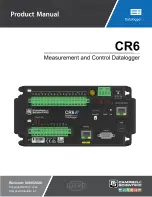
Appendix E. Engineering Output and Calibration
E-2
used will be based on frequency (Hz) and temperature and digits will
not
be
used.
When
UseDigits
is
True
, the form of the calculation polynomial is
A
*d² +
B
*d
+
C
+
D
*t² +
E
*t +
F
*d*t where d represents digits, t represents temperature,
and the upper-case letters are user-specified coefficients (constants). When
UseDigits
is
False
, the form of the polynomial is
A
*f² +
B
*f +
C
+
D
*t² +
E
*t
+
F
*f*t where f represents the frequency in Hz, t represents temperature, and
the upper-case letters are user-specified coefficients (constants).
For the proper calculation to occur, you must discern from your sensor
documentation which coefficients of the polynomial are relevant (
A,B,C,D,E
and
F
), and set all other coefficients to zero, so that they have no impact on the
output calculation. Do this by comparing your sensor manual’s calculation
equations to the polynomials listed above. Contact your Campbell Scientific
support representative if you require assistance for this step. The polynomial
coefficient schemes have already been determined for the most common sensor
types and these can be shared.
Once you know which coefficients to use, enter their values using
DevConfig
.
To specify the coefficients/constants of either polynomial shown above, use the
following CRVW3 settings:
Use this
DevConfig
Setting
To Set this coefficient
Frequency/Digits Squared (second-degree)
Coefficient
A (first polynomial
constant)
Frequency/Digits Linear (first-degree)
Coefficient
B
Constant Term
C
Temperature Squared (second-degree)
Coefficient
D
Temperature Linear (first-degree) Coefficient
E
Hybrid Temperature Coefficient (Temp*Freq
or Temp*Digits)
F
Please refer to the
DevConfig
online help topics for the
UseDigits
and
Calclulate Engineering Output
settings for more information. Relevant help
information is also found in the
DevConfig
help topics for each coefficient
setting listed in the above table.
Once the settings have been applied and the CRVW3 restarts, the calculated
output in engineering units will be given in the
ChanX_EngOut
value of the
VW_Data
output table, where X represents the channel number or ChanX is
the name you gave to the sensor/channel.
E.2 Calibration of Sensors
To enable in-field calibration on the CRVW3, set the
Use Baseline Offsets
setting to
True
,
or set the
Use Ambient Pressure Correction
setting to
True
.
Содержание CRVW3
Страница 2: ......
Страница 3: ......
Страница 7: ......
Страница 13: ...Table of Contents vi ...
Страница 121: ...Appendix A Updating CRVW3 Firmware A 4 ...
Страница 131: ...Appendix E Engineering Output and Calibration E 4 ...
Страница 133: ......
Страница 134: ......

































